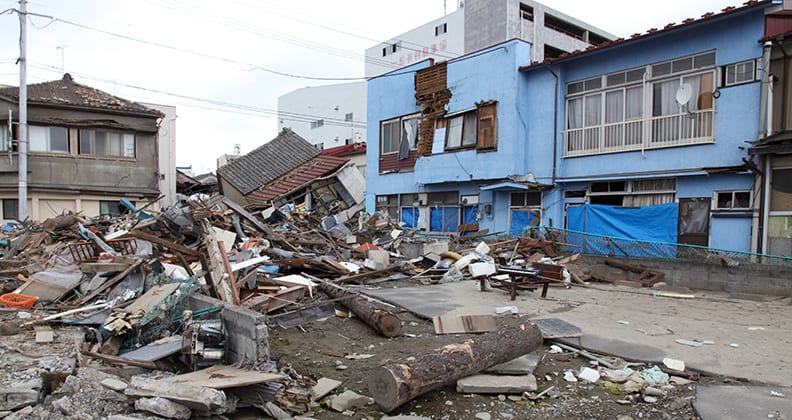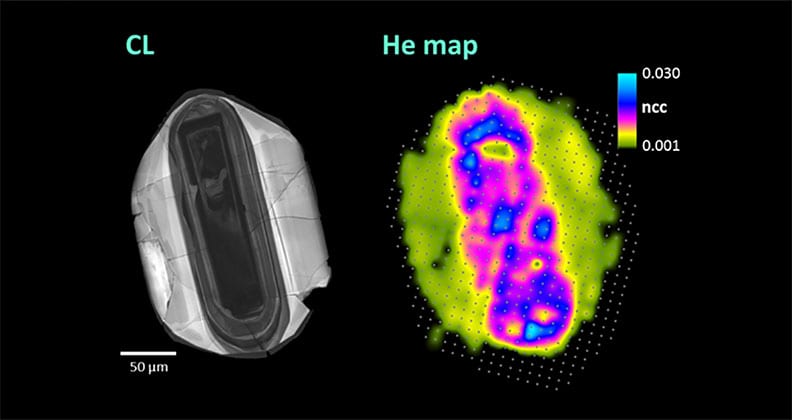Predicting earthquakes and finding diamonds could be as simple as measuring helium gas levels in zircon mineral samples, according to Curtin researchers.
Using the RESOchron – a new scientific instrument built at Curtin’s John de Laeter Centre – Curtin University scientists mapped the distribution of helium atoms inside zircon mineral samples and determined the history of the mineral by simultaneously measuring the isotopic ages of uranium-lead and uranium-helium.
They discovered that helium atoms did not sit uniformly in the mineral, as previously thought, but were scattered in patterns unique to the rock’s thermal history.
Director of the John de Laeter Centre Professor Brent McInnes says the research has important practical applications.
“We found that the patterns of helium distribution in a mineral are systematically produced in response to thermal processes, and that we can use those patterns to determine the thermal evolution of the rock it belonged to,” explains McInnes.
“If you understand a rock’s thermal history, you know when it formed and whether it has been influenced by thermal processes linked to the formation of mineral and petroleum deposits.
“You can also use thermal history analysis to determine how long it took for ancient mountain belts to form and erode away – because the faster you push mountains up into the climate, the faster they erode.”
Earthquake prediction and diamond exploration
McInnes believes his team may have stumbled across a new method to predict earthquakes, after discovering high concentrations of helium trapped within pockets of gas in the samples, which would escape once the samples were crushed.
“When you break a rock, a flush of helium is released from these gas pockets. During an earthquake, a detectable flux of helium would flow out of the fault to the surface,” he explains.
“If helium was released during rock strain prior to an earthquake event, you could deploy helium detectors along the fault line as an earthquake early warning system.”

(Photo: Shutterstock.com)
The ability to detect levels of helium could also improve the likelihood of finding diamonds, after McInnes and his team discovered low concentrations of helium in diamond-bearing vertical igneous rocks known as kimberlite pipes.
“By analysing the helium content of minerals we’ve demonstrated that it’s easy to differentiate zircon from a kimberlite pipe or from its host country rock,” says McInnes.
“These results are being used by industry in exploration, including at Ellendale Diamond Mine – the world’s leading source of yellow diamonds – in northern Western Australia.”
About the RESOchron
Zircon/helium radiometric dating is traditionally used to date geological materials, but the RESOchron is the first scientific instrument to measure a zircon mineral sample’s uranium-helium age and uranium-lead age simultaneously. It comprises three integrated instruments: a RESOlution laser ablation system and two mass spectrometers.
Through a partnership between the John de Laeter Centre and Australian Scientific Instruments Pty Ltd (ASI), the RESOchron has been sold to research institutes and centres in China, Germany and Indonesia.
“It’s not just about the scientists and the toys – it’s about partnerships. Without the funding support of ASI, none of this basic research would’ve happened,” says McInnes.
If your organisation would like to know more about the RESOchron, visit the ASI website.
Read the research paper: Seeing is believing: Visualization of He distribution in zircon and implications for thermal history reconstruction on single crystals.
Zircon/helium radiometric dating explained:
